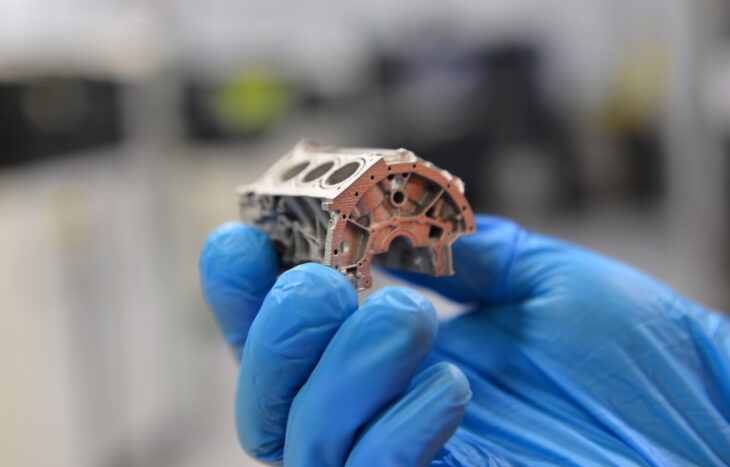Ford Motor Company and the ExOne Company have jointly developed a patent-pending process for rapid and reliable binder jet 3D printing and sintering of aluminum that delivers properties comparable to die casting.
“This is a breakthrough in making 3D printed and sintered parts for the auto industry,” said Harold Sears, Ford technical leader for additive manufacturing. “While the 3D-printing process is very different than stamping body panels, we understand the behavior of aluminum better today, as well as its value in light-weighting vehicles. High-speed aluminum 3D printing paves the way for other opportunities that we’re just now starting to take a look at because of the ability to do complex parts with aluminum that previously weren’t possible. It’s really opening doors for other opportunities.”
Binder Jet 3D Printing
Additive manufacturing, or 3D printing, has long been viewed as a potential pathway to simplify the manufacturing of aluminum, but engineers have struggled for more than a decade to deliver a commercially viable method of sintering the material when using binder jetting — considered to be the fastest method of 3D printing. Laser-based methods of 3D printing can deliver high quality aluminum products, but those processes are regarded as too slow for high volume production.
The Ford and ExOne initiated a joint development project in 2019, with the aim of developing a binder jet 3D printing technology for the production of aluminum parts. Binder jetting is a 3D printing process that uses a digital file to quickly inkjet a binder into a bed of powder particles (metal, sand, or ceramic), creating a solid part one layer at a time.
When printing metals using this technology, the final part must be sintered in order to fuse the particles together into a solid object. The heating process reinforces the strength and integrity of the metal, and while the process for sintering stainless steel is well understood, achieving high densities greater than 99% is an industry breakthrough for aluminum. The companies have verified that they are able to produce aluminum alloy 6061 with this new technology.
Ford has led the final material and repeatability testing to verify the accuracy of this binder jet 3D printing and sintering technology for aluminum. The new process is expected to increase Ford’s efficiency by allowing the company to affordably produce complex parts uniquely designed for additive manufacturing, which enables size and weight reductions, part consolidation, and performance improvements.
Collaborative and individual patents have been filed by Ford and ExOne as a result of this ongoing project. The cross-functional Ford-ExOne team is continuing to actively work on designs to use the new material and process.
“There has been skepticism for years that binder jet 3D printing and sintering of aluminum was even possible,” said Rick Lucas, ExOne Chief Technology Officer and VP, New Markets. “Manufacturers in other technology areas have struggled to deliver a commercially viable solution in this area for more than a decade. But at ExOne, we take pride in collaborating with our customers to solve the toughest challenges. We believe this innovation will help deliver lighter products and sustainability benefits that will have a sweeping impact across a wide range of products.”

